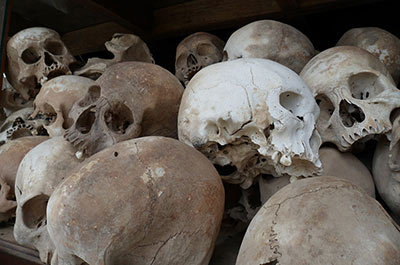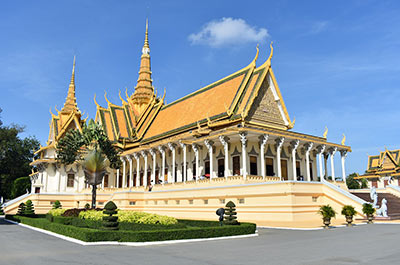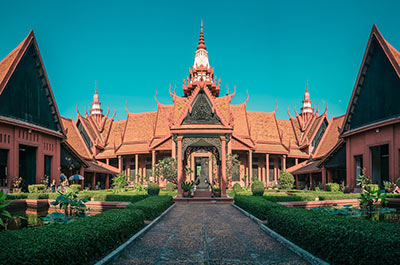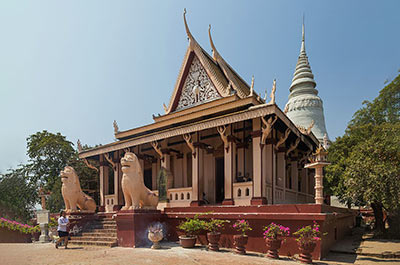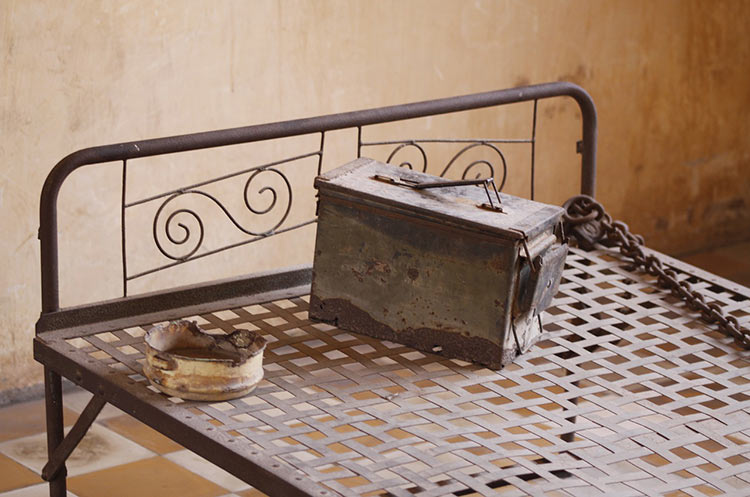
Tuol Sleng Genocide Museum
Khmer Rouge torture & death center
Tuol Sleng, also known as security prison 21 or S-21, was one of the torture and death centers of the Khmer Rouge. During the late 1970’s thousands of people were killed, only twelve people survived.
Turned into the Tuol Sleng Genocide Museum, visitors to the former prison can see prison cells, mass graves, instruments of torture and graphic photos of people being tortured.
School converted into prison
Tuol Sleng was a high school in Phnom Penh. In 1975 it was converted into a prison and interrogation center by the Khmer Rouge regime. Classrooms were partitioned into small cells where a single prisoner was kept, large cells would hold multiple people.
The prison grounds were surrounded by barbed wire to prevent escapes. Barbed wire around the higher floors of the buildings prevented people from jumping down and committing suicide.
Khmer Rouge regime
During the Khmer Rouge regime led by Pol Pot, Tuol Sleng was a place of torture and killings. An estimated 20,000 prisoners were killed between 1975 and 1979. Tuol Sleng Museum exhibits countless photos of people that died in the prison as well as of corpses in mass graves.
Prisoners
Pol Pot’s vision was to turn Cambodia into an agrarian state.
During the first years of the regime intellectuals, teachers and people who had been in contact with foreigners were imprisoned and executed. Later on when the Pol Pot regime became more and more paranoid, the party turned on its own. Members of the Khmer Rouge who were suspected of spying for the CIA or KGB or neighboring Vietnam were taken to Tuol Sleng and killed.
Across Cambodia, about two million people died during the regime of the Khmer Rouge.
Prisoner arrival
Detailed records were kept at Tuol Sleng prison. Each prisoner’s photo was taken after arrival. People had to tell their live stories, that were documented by prison staff. They were then taken to their cell and shackled to the floor on an iron bar.
Daily routine at Tuol Sleng
At 4:30 am prisoners were woken up and stripped for inspection. Then they would be interrogated and tortured to confess to whatever they were accused of. After confession they were forced to give the names of their alleged collaborators, who would be the next to be arrested and taken to Tuol Sleng. Each confession was typed out and signed by the prisoner.
Mass graves
After confessing people were killed at Tuol Sleng. Because bullets were too expensive, most were beaten to death with iron bars.
When there was no more room for new graves at Tuol Sleng, the prisoners were taken to the nearby Choeung Ek Genocidal Center, one of the killing fields. Trucks arrived there at 9 pm every day. Prisoners were taken to already dug mass graves, some of which contained up to a hundred corpses.
Torture methods
Prisoners were tortured to force them into making confessions.
Among the methods used were mock drownings, electric shocks, water boarding and beatings with a stick. Some were being hung from the ceiling, others had their fingernails pulled out. After beatings, salt water was poured into the open wounds.
After severe tortures that could go on for weeks, prisoners would confess to whatever they were charged with.
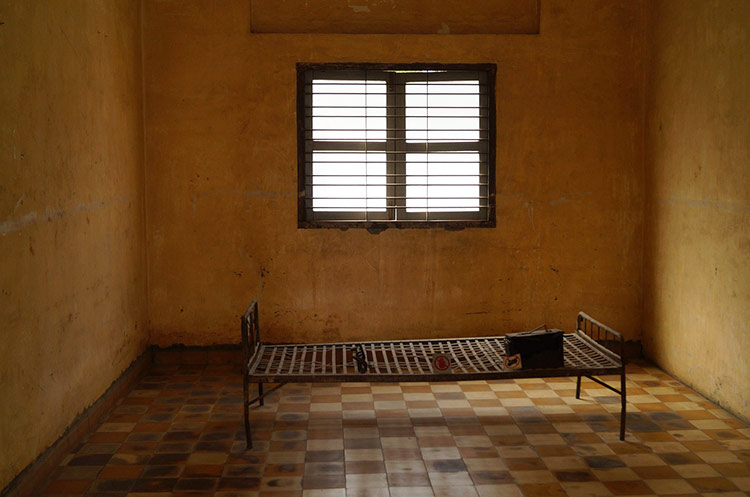
Prisoner rules
A large information board at the Tuol Sleng Genocide Museum details “The security of regulation”. This is a list of ten rules that had to be obeyed strictly, one of them being prisoners were not allowed to scream or cry during torture. Anyone who broke a rule was severely beaten.
Liberated by the Vietnamese
The prison was liberated by the Vietnamese army in 1979. Photos on display show what the prison looked like at that time. Today some of the cells look exactly how they were found in 1979.
Movies at Tuol Sleng
Two movies are show daily at Tuol Sleng Genocide Museum.
At 9:30 am: The Killing Machines, one hour.
At 3:30 pm: Behind the wall of S-21, 30 minutes.
Cultural performances
Twice daily there is a traditional music performance or Buddhist smot chanting in the White Lotus Room, building D, floor 2. Performances start at 10:30 am and at 3:15 pm and last about 30 minutes.
Lunch at “Friends”
Visitors to the museum can have lunch at “Friends”, a nonprofit organization that helps children to get training and education for the hospitality industry, so they can get jobs in hotels or restaurants in the tourist destinations around Cambodia.
Opening hours
Tuol Sleng Genocide Museum opens daily from 8 am until 5 pm.
Location
The museum is located on Street 113 in Phnom Penh, about three kilometers South West of the Royal Palace. The entrance is at the corner with Street 350.
How to get there
Get there by taxi, tuk tuk or cyclo.
A one way tuk tuk ride from the downtown area will take around 15 minutes and cost 3 - 4 US$.
If you want to visit both Tuol Sleng and the Choeung Ek Genocidal Center, you can charter a tuk tuk to visit both. Price would be about US$ 20, including waiting time.
Entrance fee
Ticket prices at the museum are:
Audio guides are available in Khmer, French, English, German, Chinese, Vietnamese, Korean, Japanese, Spanish, Dutch and Italian.
You can hire an English speaking tour guide at the entrance. There is no fixed rate, the amount paid is a donation.
Please follow the museum dress code and keep knees and shoulders covered.
Also in Phnom Penh:
